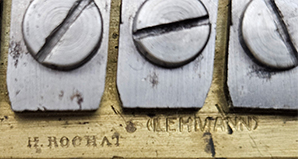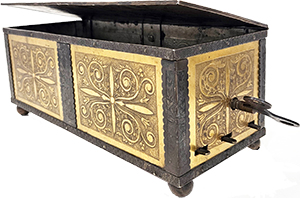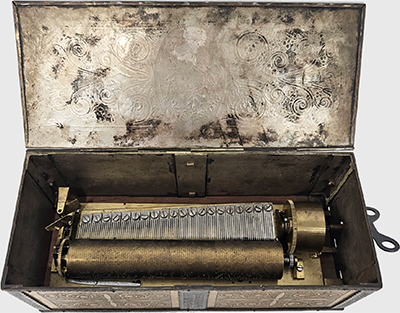Spielwerk von Henri Samuel Rochat,
Genf, 20 Sektionen à 5
und 1 à 6 Zungen,
A very rare, possibly unique early antique music box with a sectional comb and exposed controls made by H Rochat in Geneva, Switzerland c. 1820. This maker is in all likelihood Henri Samuel Rochat (1777 -1854), one of the three Frères Rochat who moved to Rue de Coutance 76, Geneva, Switzerland in about 1820. While Frères Rochat are most renowned for their singing birds, on moving to Geneva they did also manufacture other mechanical music objects. This music box is one rare example. The movement plays 4 airs that appear to be overtures, or part-overtures. The sound is fantastic and beautifully complex, especially considering the size of the cylinder (20cm / 8” long, 4cm / 1 ½” diameter). There are 20 individual combs. The first 19 have 5 teeth each, while the final treble comb has 6 teeth. The movement originally had a trigger mechanism as part of a clock, now largely removed. The movement has not been serviced (thus some small damper sounds); only the spring has been adjusted to put it in working order. The musical movement was originally made to form part of a clock. It is stamped ‘H ROCHAT’ to the bedplate along with the serial number ‘2277’. It was serviced and re-cased in Vienna, Austria by a ‘Lehmann’ in 1930, who left his stamp on the bedplate alongside that of Rochat. Lehmann’s name and the date, along with some illegible details, are also shown written in pencil on a paper spacer that was inside the spring barrel. The metal case was almost certainly made at the same time as Lehmann serviced it. The case consists of seven decoratively chased metal panels mounted within a white metal, possibly silvered cage, also elaborately decorated. It sits on ball feet. On the underside the case bears a label for Paul Jung, Jeweller, Goldsmith & Antique Store in Theresiengasse 1, Baden, Vienna, in first half of the 20th century. The case may well have been made specifically by Herrn Jung for this musical movement, which would explain why, despite the beautiful musical details chased into the metal, it is in metal rather than wood, and the movement is cased upside down. The lid also doesn’t close fully, so the case is an eccentric but nonetheless charming and intrinsic part of this unique music box’s history. Cylinder size: 8" / 20cm long, 1 ½" / 4cm diameter Case: Width: 12 ¼" / 31cm, Height: 4 ¾" / 12cm, Depth: 4 ¾" / 12cm
|





